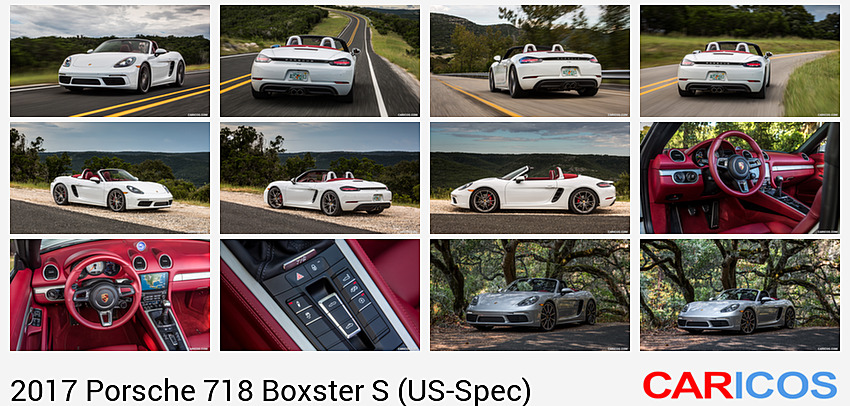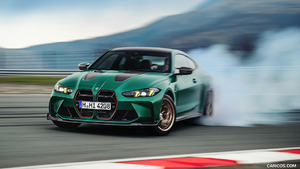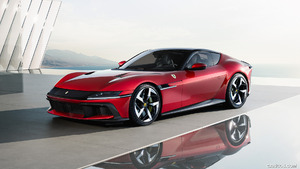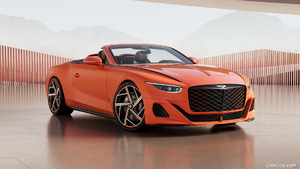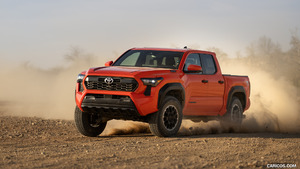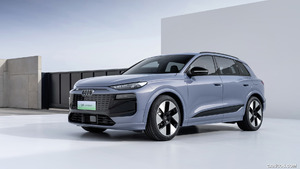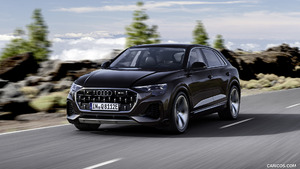Porsche 718 Boxster S (US-Spec)
Twenty years after the first Boxster made its debut, Porsche is introducing the latest generation of its mid-engine roadster featuring more power and even better handling. The new models are named 718 Boxster and 718 Boxster S, paying homage to the flat four cylinder engines that were used in the mid-engine Porsche 718 sports car which won numerous races back in the late 1950s and early 1960s, including the legendary Targa Florio and Le Mans.
The centerpiece of the latest model range is the newly developed, turbocharged flat fourcylinder engine. The 718 Boxster generates 300 horsepower from two liters of displacement, while the 718 Boxster S uses a 2.5 liter engine developing 350 horsepower. The S-model also employs a turbocharger with variable turbine geometry (VTG). Porsche is the only manufacturer to use VTG technology in production models with gasoline engines – in the 911 Turbo, the 718 Cayman S and the 718 Boxster S. The new engines develop 35 more horsepower compared to those of the previous Boxster.
The completely retuned suspension and uprated brakes lay the foundation for exceptional performance and driving pleasure. The design of the new model line was also comprehensively improved. Every body part except for the luggage compartment lids, the windshield and the roadster top has been changed. Inside, a newly designed dash panel frames the cockpit. The level of standard equipment has been increased compared to the predecessor, including Bi - Xenon headlights and Park Assist front and rear with a reversing camera. Furthermore, the latest generation of Porsche Communication Management (PCM), with a state-of-the-art touchscreen, SiriusXM®, HD radio, and Universal audio interface, is included as standard. The navigation module is available as an option.
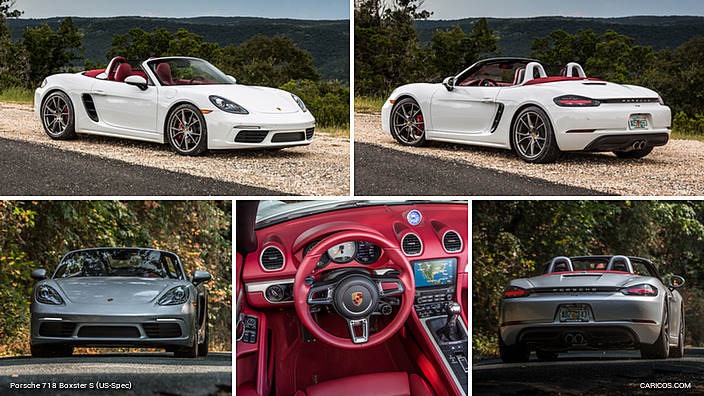 2017 Porsche 718 Boxster S (US-Spec)
2017 Porsche 718 Boxster S (US-Spec)
The 718 Boxster has a starting MSRP of $56,000, and the 718 Boxster S from $68,400, excluding the $1,050 destination charge.
Powerful flat-four cylinder engines
A completely new generation of turbocharged flat-four cylinder engines takes performance in the 718 Boxster to new heights – and represents the first time Porsche is equipping sports cars with flat four-cylinder engines since production of the 912 E ended 40 years ago. Turbocharging significantly boosts torque. The two-liter engine of the 718 Boxster puts out 280 lb.-ft. of torque, which is available from 1,950 rpm to 4,500 rpm. To put this into perspective: The new engine makes 74 lb.-ft. or 36 percent more torque than the previous powertrain and does so over a much broader power band. The 2.5-liter engine of the 718 Boxster S develops 309 lb.-ft. from 1,900 rpm to 4,500 rpm – a 43 lb.-ft. gain over the outgoing Boxster S engine.
This yields significant gains in acceleration. The 718 Boxster – when equipped with PDK and the Sport Chrono Package – sprints from zero to 60 miles per hour in 4.5 seconds (0.7 seconds faster than the previous model). The 718 Boxster S outfitted with these performance-enhancing options reaches 60 miles per hour in 4.0 seconds (0.5 seconds faster than its predecessor).
The top track speed of the 718 Boxster is 170 miles per hour (8 miles per hour faster than before), and the 718 Boxster S can achieve a top track speed of 177 miles per hour (5 miles per hour faster than previously).
True to their pure, driver-focused character, the 718 Boxster models come standard with a sixspeed manual transmission. The Porsche Doppelkupplungsgetriebe (PDK), which now features virtual gears, is available as an option.
New design emphasizes sharpened profile
The 718 Boxster and Boxster S are immediately recognizable. The front has been resculpted and has a wider, more muscular appearance. Significantly larger cooling air intakes serve as a distinct symbol of the new turbocharged engine generation. Redesigned Bi -Xenon headlights with two integrated LED daytime running lights are another striking feature, now fitted as standard. Two headlight options are available, including a Bi-Xenon headlight with an LED high beam plus and a daytime running light module with 4 LEDs, while the top offering comes as full LED headlights with four-point daytime running lights – a first for the mid-engine roadster. Glancing at the car from the side, defining features of the new model line include new, independently styled fenders and side skirts. Larger air intakes with two vanes emphasize the car's dynamic look. The doors now do without door handle recess covers. New 19-inch wheels are standard on the 718 Boxster S. 20-inch wheels are optionally available.
The redesigned rear fascia of the 718 Boxster models places a much greater emphasis on width – especially due to the strip with integrated Porsche badge located between the tail lights. The new taillights stand out thanks to three-dimensional LED technology and four-point brake lights.
Sportier suspension tuning and calibration for greater agility
The outstanding dynamic performance of its namesake served as inspiration to continue to improve upon the exceptional handling of the mid-engine roadster. The 718 Boxster’s completely retuned suspension enhances cornering performance. Adopted from the 911 Turbo, the electric steering system’s ratio is ten percent more direct on center than previously. This not only increases agility and precision but also maneuverability on challenging roads and tracks as well as in every-day traffic.
Optionally available: Porsche Active Suspension Management
Porsche Active Suspension Management (PASM) is available as an option and includes a 0.43 inch (10 millimeter) lower ride height compared to the standard suspension. For the first time, the PASM Sport Suspension with a 0.86 inch (20 millimeter) lower ride height is available as an option for the 718 Boxster S. The suspension with adaptive dampers, which has also been retuned, offers an even broader spread between ride comfort suitable for long road trips and stiffness necessary for spirited driving.
Sport Chrono Package for particularly engaging driving experience
Just like in the 911, the optional Sport Chrono Package now includes the steering wheel mounted Mode switch with an Individual program in addition to the three settings Normal, Sport and Sport Plus. In models equipped with PDK, the Sport Response Button, which was inspired by motorsports, has been added. It sharpens the responsiveness of the engine and the transmission to promote best possible acceleration.
New Porsche Communication Management as standard
A familiar environment awaits the driver inside the new 718 Boxster, which has been upgraded with new elements such as the instrument panel. Another defining element of the new interior layout is the Porsche Communication Management (PCM) unit with mobile phone preparation (Bluetooth™), audio interfaces and the 110 watt Sound Package Plus. The PCM can be enhanced with a navigation module including voice control. Beyond that, the Connect Plus module is available as an extension of the navigation module, providing a wide array of online services.
New turbocharged flat four-cylinder engines
Increased power for a higher level of performance
In the 718 Boxster, Porsche is introducing two completely new turbocharged flat four-cylinder engines. This boosts power significantly compared to previous engines, while a number of innovations ensure typical Porsche driving pleasure, promoting greater responsiveness, freerevving nature up into the highest rpm range and passionate sound.
The new turbocharged flat four-cylinder engines are available in two power stages: The two-liter version in the 718 Boxster puts out 300 horsepower, while the 2.5-liter power plant in the 718 Boxster S develops 350 horsepower. Compared to the previous Boxster models, this represents a 35 horsepower increase for each model. The two-liter engine of the 718 Boxster puts out 280 lb.-ft. of torque, which is available from 1,950 rpm to 4,500 rpm. To put this into perspective: The new engine makes 74 lb.-ft. or 36 percent more torque than the previous powertrain, and does so over a much broader power band. The 2.5-liter engine of the 718 Boxster S develops 309 lb.-ft. from 1,900 rpm to 4,500 rpm – a 43 lb.-ft. gain over the outgoing Boxster S engine.
Torque advantage: quicker acceleration from any speed
Thanks to the significant increase in torque, the new 718 Boxster models offer superior acceleration compared to their predecessors. The 718 Boxster – when equipped with PDK and the Sport Chrono Package – sprints from zero to 60 miles per hour in 4.5 seconds (0.7 seconds faster than the previous model). The 718 Boxster S outfitted with these performanceenhancing options reaches 60 miles per hour in 4.0 seconds (0.5 seconds faster than its predecessor). The engines rev up to 7,500 rpm – characteristic of a thoroughbred sports car engine. The driver can make use of the engine's power and torque over a broad rpm range of revs without having to shift, and the full torque of the turbo engine is available immediately after a gear change. The top track speed of the 718 Boxster is 170 miles per hour (8 miles per hour faster than before), and the 718 Boxster S can achieve a top track speed of 177 miles per hour (5 miles per hour faster than the previous model).
Flat four-cylinder engines and turbocharging as traditional Porsche competencies In the new engine generation, Porsche is combining two technologies that each have a longstanding tradition within the brand: the flat four-cylinder engine and turbocharging. The engine layout with pairs of horizontally opposed cylinders offers a number of advantages. The balance of inertial forces guarantees smooth engine operation. Horizontal cylinders allow for a design with a very low center of gravity, making them the preferred choice for sports cars. The short crankshaft also makes flat engines very compact in size and free-revving in nature.
The two engine variants of the new 718 Boxster are not just distinguished by their displacement. The two-liter engine, which operates with a maximum boost pressure of 20.3 psi (1.4 bar), employs a turbocharger with an integrated bypass valve (wastegate) to feed additional air into the combustion chambers. The more powerful 2.5 liter engine, with 14.5 psi (1.0 bar) maximum boost pressure, uses a turbocharger with variable turbine geometry - a technology that was first used by Porsche in the 911 Turbo. The principle of adjustable guide vanes, which direct the exhaust gas stream variably and accurately onto the turbocharger's turbine wheel, combines the advantages of small and large turbochargers. While largely closed guide vanes provide for good response and high torque at low revs, open guide vanes enable the engine to develop the maximum amount of horsepower at high revs. A highlight of the turbo four-cylinder in the 718 Boxster S: for the first time, an integrated wastegate precisely controls the exhaust gas stream in a targeted manner, allowing the turbocharger with its adjustable guide vanes to operate at the highest possible level of efficiency.
Spontaneous throttle response reminiscent of a naturally-aspirated engine and Dynamic Boost function
Porsche engineers placed a particular priority on achieving engine responsiveness that is comparable to that of a naturally-aspirated engine. This is possible by 'pre-conditioning' the turbocharger at partial load during spirited driving when the Sport or Sport Plus mode is active. The bypass valve (wastegate) is closed, the timing angle is reduced and the throttle valve is opened slightly. This increases the air flow rate through the engine which allows it to maintain a higher level of boost pressure. When the driver applies full throttle, the higher boost pressure noticeably improves the engine’s responsiveness and torque buildup. This 'pre-conditioning' varies according to the selected drive mode – Sport or Sport Plus.
Furthermore, the new Dynamic Boost function improves throttle response when the driver briefly lifts off the accelerator pedal during full acceleration and then gets back on it. At this time, the throttle valve remains wide open, while fuel injection is stopped. As a result, boost pressure does not drop completely, and the engine reacts promptly when the throttle is reapplied, comparable to a naturally-aspirated engine. This effect is most pronounced in the Sport and Sport Plus modes.
The turbocharger operates similarly when the Sport Response button is pressed. Just like in the latest generation of 911 models, this button is located in the center of the mode switch on the steering wheel in vehicles equipped with the Sport Chrono Package and PDK transmission. Inspired by motorsport, it calibrates the engine and transmission to provide the maximum amount of acceleration and responsiveness for 20 seconds. At partial load, the wastegate of the turbocharger is closed, allowing it to build up boost pressure much faster. The engine responds more spontaneously to throttle inputs, and it reaches its maximum power faster. Additionally, the PDK immediately downshifts to a lower gear, and a special calibration is used with shift points that are even higher than in Sport Plus mode.
Water-to-air intercooling via extended cooling circuit loop
Porsche engineers have developed another innovative solution in the form of water-to-air intercooling. To avoid detrimental effects to the design and aerodynamics of the 718 Boxster, the turbo engines use the air intakes behind the doors for induction of process air and for water-to-air intercooling. The temperature of the charge air is reduced by an auxiliary loop of the cooling circuit. An intercooler mounted above the engine transfers heat from the turbocharger‘s compressed air to the coolant. The coolant then flows through a pair of radiators located behind the left and right air intakes.
The engines of the new 718 Boxster and Boxster S share technologies used in the three-liter twin-turbo engines of new 911 Carrera to enhance their performance capability. Two directinjection fuel pumps supply the system with a pressure of up to 3625 psi (250 bar). Previous models had a side injector position with 4- or 6-hole injectors and a maximum injection pressure of 120 bar. Centrally positioned 7-hole fuel injectors allow for optimal combustion.
Furthermore, the use of a now adjustable exhaust camshaft with valve stroke adjustment makes it possible to control the charge air exchange process even more precisely. On the intake side, Porsche continues to use the VarioCam Plus system. The dual-side, adaptive valve train with reduced friction helps to ensure spontaneous throttle response at low engine speeds that is characteristic of a Porsche. By implementing the new cylinder lining process used in the threeliter 911 Carrera engines, in which a plasma beam coats the cylinder surface with iron, the engineers were able to minimize frictional losses.
Like the 911 engines, the flat four-cylinder engines also feature a fully variable oil pump and a thermal management system with a water pump that operates on demand and is controlled in two stages.
Completely new exhaust systems for passionate sound
The newly developed exhaust systems guarantee passionate, Porsche-typical sound. Exhaust gases from the four cylinders are merged just before the turbocharger which is mounted to the engine directly behind the driver’s seat. The single exhaust tract runs past the engine and then branches into two pipes in front of the transmission. Like on the previous model, these run past the transmission to the two rear mufflers.
In the 718 Boxster, the exhaust gases flow through a system with a central single oval tailpipe made of brushed stainless steel. The 718 Boxster S has round twin tailpipes made of brushed stainless steel. Two central round sport tailpipes available in chrome or black highlight the optional Sport Exhaust System with an exhaust flap, which is available for all models. The exhaust flap can be activated with a button on the center console. The flap opens automatically at an engine speed of around 3,500 rpm or higher, providing a particularly deep and sonorous sound.
Six-speed manual transmission as standard, optional seven-speed PDK
The 718 models come with a six-speed manual transmission as standard, which has been reinforced with new components and a stronger clutch due to the increased torque of the new turbocharged engines. The Porsche Doppelkupplung (PDK) with seven gears is available as an option and has also been strengthened with new components. Like in the latest generation of 911 models, the direction of shifting in manual mode has now been reversed to correspond to the logic used in race cars: pushing the gear selector forward initiates a downshift, pulling it back commands an upshift. Furthermore, the transmission holds the driver-selected gear and does not upshift at redline in manual mode.
Additional pendulum-type absorbers have been integrated in the dual-mass flywheel to support engine smoothness and reduce vibrations at very low engine speeds. The PDK features the enhanced Auto Start/Stop function, which shuts off the engine when the car is coasting to a stop. If required, this function can be deactivated using a button on the center console, and is automatically shut off in Sport and Sport Plus mode.
The virtual gears familiar from the 911 models are now included on the 718 models equipped with PDK. If the transmission control unit detects that the vehicle is traveling at a constant speed, it changes to a higher gear until the engine would theoretically be running at around 800 rpm. This bears significant fuel saving potential, but impairs smoothness due to possible drivetrain vibrations. To maintain comfort, the transmission control unit automatically increases the engine speed by allowing for a small amount of clutch slip. Because the clutches are bathed in oil, this does not increase wear.
Optimized Sport Chrono Package as an option
The optional Sport Chrono Package enhances the performance capabilities of the new 718 Boxster. Just like in the latest generation of 911, it now includes the Individual mode in addition to the three settings Normal, Sport and Sport Plus. The driver can individually configure the PASM, Sport Exhaust System, auto start/stop function, and rear spoiler by programming them using a specific menu in the instrument cluster and then save them as a preferred setting. In models with PDK, the Sport Response button is also added, which is located in the center of the mode switch. Inspired by motorsports, it enables the driver to configure the drivetrain to deliver maximum responsiveness and acceleration at the push of a button, for example before overtaking another vehicle. In conjunction with the Sport Chrono Package, Porsche Stability Management (PSM) of the 718 Boxster models features a PSM Sport mode. In this setting, ambitious drivers can approach the limits of the car more closely in a safe environment, such as an enclosed track. The PSM always remains active in case it is needed. In combination with the upgraded Sport Chrono Package, this leads to a particularly engaging and thrilling driving experience.
Tradition and future: Porsche four-cylinder engines show impressive success in racing
The 718 Boxster adopts a proven powertrain concept and is the latest model in an extensive history of renowned Porsche sports cars. The most recent example of this is the 919 Hybrid LMP1 race car, which also has a highly-efficient turbocharged four-cylinder engine with just two liters of displacement. Not only did Porsche take first and second place in the 24 hours of Le Mans in June 2015, but also won the manufacturers and drivers titles in the World Endurance Championship (WEC). As a result, the 919 Hybrid proves how much performance can be extracted from a four-cylinder engine developed by Porsche.
Mid-engine sports cars with flat four-cylinder engines have a long-standing tradition at Porsche. The 356/1 laid the groundwork in 1948; it was the first vehicle to bear the Porsche name. The Porsche 550 followed in 1953, and it impressively demonstrated the superiority of the midengine concept combined with a systematic lightweight design. In 1956, the 550 won the Targa Florio race, leading the second place car by over 15 minutes. The 550 was succeeded by Porsche 718, which was built using the same approach: light, fast and beautiful. Based on its favorable power-to-weight ratio, the extremely agile two-seater was able to reach peak speeds of up to 160 miles per hour, making it even more successful than its predecessor. The 718 won the Targa Florio in 1959, 1960 and 1963.
Driving dynamics of the 718 Boxster
New tuning and calibration for even better handling
The mid-mounted engine configuration has proven to be a good baseline for optimal driving dynamics. Exhibiting extraordinary agility, the new 718 Boxster and Boxster S follow in the tracks of the original 718. A completely retuned chassis takes cornering and agility to a new level. For a 718 Boxster S equipped with all performance-enhancing options, Porsche is expecting lap times on the North Loop of the Nürburgring that are 16 seconds faster than those of the previous model, putting the car on the same level as a Boxster Spyder and close to that of a Cayman GT4.
Adaptive engine mounts improve comfort and handling
Agility and handling are not only influenced by the position of the engine, but also by the way it is mounted. The flat four-cylinder engine is positioned to offer a nearly ideal weight distribution ratio of 45 to 55 percent between the front and rear axles. The 718 Boxster models now feature a four-point drivetrain mount, compared to the three-point mount of the previous generation. The engine now has two switchable and vacuum-controlled engine mounts in comparison with the central engine mount of the previous model. The powertrain is still supported by two rear transmission mounts like on the previous model, and are upgraded to adaptive dampers with the Sport Chrono Package. When the engine is idling, the engine mounts are uncoupled to provide the highest possible level of vibration damping and comfort. While driving, a stiffer setup of the mounts minimizes disturbances related to drivetrain movement. When equipped with the optional Sport Chrono Package, dynamic transmission mounts offer an even broader spread between ride comfort and precise handling. With an improved control system, the new generation of dynamic transmission mounts adapts even better to changing driving situations.
New suspension components and calibration for more precision and stability
To further enhance precision and lateral stability in driving performance, Porsche modified many components of the rear suspension. A new cross member strengthens the rear subframe, improving lateral rigidity. Shock absorbers with larger pistons also improve wheel guidance due to their greater rigidity. The rear wheels, which are half an inch wider than on the previous model, increase grip and improve cornering stability together with the new generation of tires, which offer increased dry and wet performance as well as reduced rolling resistance. Retuned hydraulic vibration dampers as well as higher sway bar and spring rates reduce pitch and roll to a minimum. Porsche has also fitted the standard suspension with additional rebound buffer springs. They reduce front body lift under acceleration and body roll during hard cornering. At the same time, they also enhance comfort by improving suspension fidelity on bumpy surfaces.
Ten percent more direct: steering adopted from 911 Turbo improves handling The electromechanical steering system, which is ten percent more direct, makes the 718 Boxster even more agile and easier to handle during spirited driving and in traffic. The new model incorporates the steering gear of the 911 Turbo with its quicker ratio. Power Steering Plus is available as an option. It reduces steering effort at low speeds while maintaining a reassuring level of stability at higher speeds.
The driver takes control of the 718 Boxster via a new generation steering wheel featuring a design based on the steering wheel of the 918 Spyder. When equipped with the optional Sport Chrono Package, the steering wheel features a mode switch, which was derived from the hybrid map switch found in the 918 Spyder. The mode switch consists of a rotary dial with four positions for the driving modes Normal, Sport, Sport Plus and Individual. On cars equipped with the optional PDK transmission, the Sport Response button is added.
Optional PASM sport chassis with 0.86 inch (20 mm) lower ride height offered for first time
Porsche Active Suspension Management (PASM) with a 0.43 inch (10 millimeter) lower ride height is available as an option on the 718 Boxster and Boxster S. Furthermore, the 718 Boxster S can be ordered with the PASM sport chassis with a 0.86 inch (20 millimeter) lower ride height. It offers a significantly stiffer setting in Sport mode to suit particularly spirited drivers. Both optional suspensions offer an even greater spread between ride comfort and agile handling thanks to extended sensor technology with an increased bandwidth of damper control. At each spring strut, a height sensor now measures ride height, and three accelerometers measure the g-load into the chassis, enabling an even more precise and sensitive control.
Optional Porsche Torque Vectoring (PTV) improves traction and agility
Using variable torque distribution and a mechanical differential lock at the rear axle, the optional Porsche Torque Vectoring system improves turn-in and traction when entering or exiting a corner. When turning into a curve at high speed, moderate brake pressure is applied to the inside rear wheel. As a result, the outside rear wheel receives a higher drive force, allowing for additional angular momentum in the direction the vehicle is being steered, thus improving turn-in precision and agility. When accelerating out of a corner, the mechanical differential lock provides additional traction and stability.
Upgraded brakes with multi-collision braking system
The 718 Boxster now employs the brake system that was previously used in the Boxster S, with front brake rotors measuring 13 inches (330 millimeters), representing a 0.6 inch (15 millimeter) increase compared to the previous model. The 718 Boxster S is equipped with the new four-piston calipers and thicker brake rotors (34 millimeters instead of 28 millimeters) of the 2017 911 Carrera on the front axle. The Porsche Ceramic Composite brake system (PCCB) with rotors measuring 13.8 inches (350 millimeters) at all four wheels is available as an option. The 718 Boxster models also come standard with the multi-collision braking system. The system can reduce the severity of a secondary collision by automatically braking the vehicle after an initial collision triggering an airbag deployment.
Porsche Stability Management with new “PSM Sport” mode
When equipped with the optional Sport Chrono Package, the Porsche Stability Management system offers a separate mode known as PSM Sport that is activated by briefly pushing the PSM button on the center console. PSM Sport differs significantly from the PSM On setting, and is now activated independently of the Driving Mode (Normal/Sport/Sport Plus). When the PSM Sport mode is activated, an indicator in the instrument cluster and the yellow “PSM Off” lamp are lit to inform the driver.
The new PSM Sport mode lets drivers approach the limits of the vehicle more closely on enclosed tracks. Compared to PSM On, the new mode permits much larger yaw angles as well as more wheelspin and allows the driver to experience the sports car's dynamic performance more intensely. It also makes it unnecessary to fully deactivate PSM. However, the PSM Off mode is still available by pressing the PSM button for a longer period of time, staying true to the Porsche philosophy of giving the driver full control over the vehicle. As a safety precaution, hard braking triggering the ABS activates the full range of PSM stability control until the brakes are released.
Design of the 718 Boxster
Fresh but familiar: distinctive exterior, interior with new PCM as standard For the past 20 years, the Porsche Boxster has stood for timeless roadster design, a clearly defined mid-engine concept and a classic convertible top. The 718 Boxster emphasizes this strong character more than ever with even more precise edges and curvatures, large wheels, narrow tire gaps, and short overhangs. The new model line has been enhanced as comprehensively in its design as it has in its technology. Only the front and rear luggage compartment lids, windshield and convertible top were left unchanged. The taut proportions, emphasized air intakes on the front and sides as well as the low silhouette underscore the roadster's higher level of performance.
The 718 Boxster and Boxster S are immediately recognizable. The front end is flatter and looks wider with its lines running outward. This effect is reinforced by narrow front lights above the outer cooling air intakes, which incorporate the positioning lights and direction indicators. The nose is lower, enhancing the overall impression of the vehicle being closer to the road. Design edges on the upper front body reflect the lines of the V-shaped profile. The center part of the front end features two new horizontal design elements that also emphasize the width of the 718 Boxster. Significantly larger cooling air intakes serve as a distinct symbol of the new turbocharged engine generation. Redesigned Bi-Xenon headlights with two integrated LED daytime running lights are another striking feature, now fitted as standard. Two headlight options are available, including a Bi-Xenon headlight with an LED high beam plus and a daytime running light module with 4 LEDs, while the top offering comes as full LED headlights with fourpoint daytime running lights – a first for the mid-engine roadster.
Distinctive air intakes draw attention to the new turbo engines
Glancing at the car from the side, the new 718 Boxster models stand out not just because of the unmistakable flyline, but also thanks to redesigned and more precisely defined mirrors, fenders, doors, air intake covers and sill covers. The new mirrors are equipped with a V-shaped base and help emphasize the sporty overall appearance of the 718 Boxster. Other details include the new door handles without recess covers, giving the door a flusher look. With its even more clearly defined edge, the indentation in the door leads to the redesigned air intake with 2 vanes. The enlarged air intake cover is another indication of the 718 Boxster‘s increased performance. The sill cover also has a much more visible edge, which makes the vehicle appear closer to the road. It also makes the car seem lighter in the middle. The rear fenders are less arched, emphasizing the width of the 718 Boxster. There is also a revised choice of wheels. The 718 Boxster is fitted with the familiar 18-inch Boxster wheels, while the 718 Boxster S comes standard with 19-inch Boxster S wheels in a new design.
Wide rear fascia with three-dimensional Porsche logo
The redesigned rear fascia of the 718 Boxster looks wider and even more dynamic due to the high-gloss black trim strip that features an integrated Porsche logo between the taillights. The three-dimensional design of the Porsche logo gives the brand name a completely new appearance. The completely redesigned taillights are distinguished by the three-dimensional interior components which are plainly visible through the clear glass. Their night design stands out with sharp and homogeneous running and brake light designs. The reversing lights are integrated into the four fingers of the brake lights.
The wider rear fenders and the aerodynamically optimized shape of the rear wing profile fit in perfectly with the wider-looking rear fascia. A refined rear wing actuator allows the aerodynamic balance to be optimally adjusted depending on whether the top is retracted or not. The wing extends 1.77 inches (45 millimeters) when the roof is closed, and 2.17 inches (55 millimeters) when the top is open. As before, the third brake light is positioned on the rear luggage compartment lid. The larger number of individual LEDs provide homogeneous illumination of the third brake light. This produces a light design that complements the light design of the taillights. The additional light edge level with the reflectors emphasizes the width and stance of the vehicle. The diffuser is higher, and the larger black area makes the rear fascia look lighter. Integrated into the rear diffuser, the 718 Boxster has a central single tailpipe, while the 718 Boxster S has a central twin tailpipe to indicate its greater engine power.
Restyled interior has new Porsche Communication Management as standard
The interior picks up on the exterior’s consistent emphasis of horizontal lines and is characterized by an even higher quality and functionality that is typical for Porsche. The impressive leather trim has stitching which continues to the storage compartment. With its elevated air vents, the redesigned upper part of the dash panel reflects the distinguished threedimensional exterior design. The lid of the center console has been raised slightly compared to the previous model to provide more comfort. A sport steering wheel in the design of the 918 Spyder measuring 14.8 inches (375 millimeters) in diameter is standard. The 14.1 inch (360 millimeter) GT Sport steering wheel is available as an option. Porsche offers multifunction and steering wheel heating as options for all steering wheel versions. Moreover, five new interior colors are available for the 718 Boxster.
A central element of the new interior layout is the Porsche Communication Management (PCM) unit which consists of a high-resolution, 7-inch color touchscreen with a high quality glass cover, proximity sensors and multi-touch gesture control. It also includes mobile phone preparation, 2 SD card readers with single CD/DVD drive, universal audio interface with an 11 GB jukebox and the 110 watt Sound Package Plus. Sound systems from Bose and Burmester are optionally available.
The PCM can be enhanced with optional modules. The Connect module comprises an iPodcapable USB port on the center console, Apple CarPlay including “Siri" voice control and Porsche Car Connect. Available in conjunction with the optional navigation module, Connect Plus additionally offers wireless internet access, an LTE telephone module, Google Earth and Google Street View and the Porsche Connect app.
Porsche Car Connect provides access to trip data such as the distance covered, average speed, fuel consumption and the current fuel level. The app can also display where the car is parked, or whether the roof, luggage compartment or doors are opened, closed or locked. To find the vehicle quickly in crowded parking lots, the horn or hazard lights can be activated. The user can also navigate from his or her current location to the car using the app. Pending maintenance appointments and the current tire pressures are also displayed. Furthermore, the app can be used to make an emergency call or report a breakdown, sending vehicle data and location to an emergency call center or Porsche Assistance.
Optional navigation and Connect Plus modules offer even more new functions
Available as an alternative is the navigation module with voice control which makes it easy to input driving destinations. The navigation module has an improved map display and can show maps two-dimensionally or in perspective. 3D representations are also possible in select regions. The module includes free map updates within the first three years. The Connect Plus module is available as an extension of the navigation module. It enables simple interfacing of a smartphone to the PCM, wireless Internet access for WiFi devices as well as using online functions such as information navigation services, and features an LTE telephone module.

